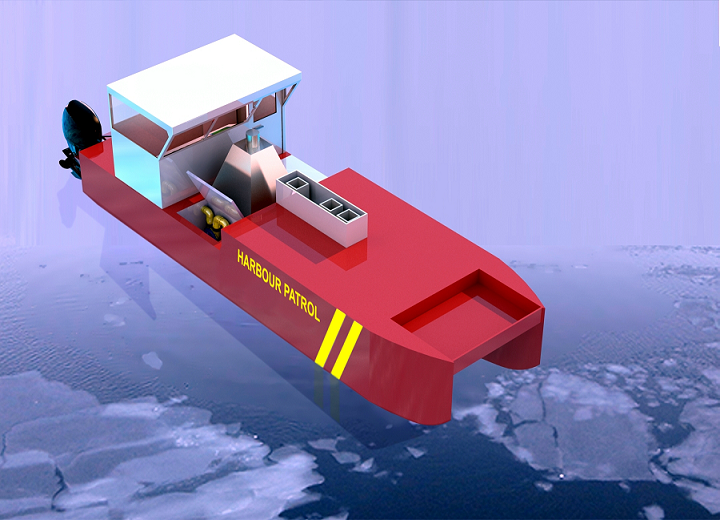| Home Page |
| The Problem |
| Solutions |
| Products |
| Services | Our Approach |
| About ROSCUE |
| Contact Us |
| Library |
| Opportunities |
| Fine Print |
Products: Gravity Tower Oil Spill Recovery VesselsThe best way to clean up an oil spill on water that you have never heard of. What you need to know: it's simple and it works! The technology relies on 3 key facts: gravity works; oil floats on water; and, oil and water don't like to mix.
Gravity-based oil spill recovery. Proven again and again with multiple models and vessels. Simple, robust, reliable, scalable. Intended to be incorporated in multi-function vessels so they can earn their keep daily, but shift to spill recovery in under an hour. Do you have an oil spill risk on a sizable body of water, such as a lake, river, harbour or on open water? These vessels should be your front-line spill response and recovery tool. The patented gravity-based oil spill recovery vessel is a quantum leap forward in the field of recovering oil (and refined oil products) spills on water. Unlike the current 'state-of-the-art' in use by most oil-industry-owned oil spill response organizations, these vessels can recover over 90% of the oil encountered, even in waves and near-gale conditions (data validated by OHMSETT, the most respected oil spill response testing facility in North America - backgrounder available on request). Compare that to 15% as the maximum in ideal test conditions (warm, full daylight, still water, no wind) for conventional skimmers in widespread use today, and 3% actual recovery in the wake of the DeepWater Horizon spill. This technology has been evaluated by the Canadian Coast Guard which issued a glowing evaluation report (available on request).
The Harbour Patrol and Oil Spill Recovery Vessel (10 metres LOA) This vessel is designed from the outset as a weather-capable, multi-function boat or ship. It does not sit idle waiting for an oil spill to happen. Instead, it earns its keep in a 'day-job' (such as fishing, harbour patrol, pilot boat, off-shore drilling platform support vessel, cargo carrier, fireboat, search & rescue) near likely spill areas (e.g., pipeline water crossings and terminals, harbours and bunkering areas, oil tankers), and can convert to spill recovery operations in less than an hour. Compare that to current general practice which takes days to put spill recovery vessels on site.
The Ocean Capable Off-shore Rig Support and Oil Spill Recovery Vessel (55 metres LOA) Hydrodynamic Simulation and Optimization of an Oil Skimmer (ASME Paper) Abstract "Oil spills can cause severe environmental damage. In situ burning or chemical dispersant methods can be used in many situations; however, these methods can be highly toxic and fail in slightly rough seas. Oil recovery techniques have also been developed to recover oil using skimmer equipment installed in ships. The challenges arise when a vessel is operated in heavy sea and current conditions. An oil skimmer has recently been developed by Extreme Spill Technology (EST) Inc. for automated oil recovery using a vacuum device installed in a vessel. Initial tests have shown that the prototype vessel is efficient in oil recovery. This paper presents the numerical and experimental studies of the hydrodynamic performance of the vacuum tower installed in the oil skimmer developed by EST. While the principle of the vacuum mechanism for oil skimming is simple, the hydrodynamic aspects of the recovery process is very complicated since it involves multiphase and multiscale moving interfaces, including oil, water, atmospheric air, and attenuate compressible air on the top part of the vacuum tower, and moving interface of oil slick, oil droplets, and air bubbles of different scales. The recovery process was simplified into a three-phase flow problem involving oil, water, and air and was simulated by using a computational fluid dynamics (CFD) method. The volume of fluid (VOF) method was employed to capture the moving surfaces between the fluid phases. Model tests were carried out to simulate the oil recovery process and for validation studies. Numerical results were compared with the experimental data. Studies were also extended to optimize the geometry of the tower for maximum oil recovery." ROSCUE is one of only two licensed agents for this technology worldwide. Pricing: Building boats is a bespoke business. We will work with you to design and build a vessel which meets your needs for both oil spill recovery and primary vessel functions, sized to your application. E-mail to outline your needs and begin the process to deliver truly world class oil spill response for your community or organization. |






